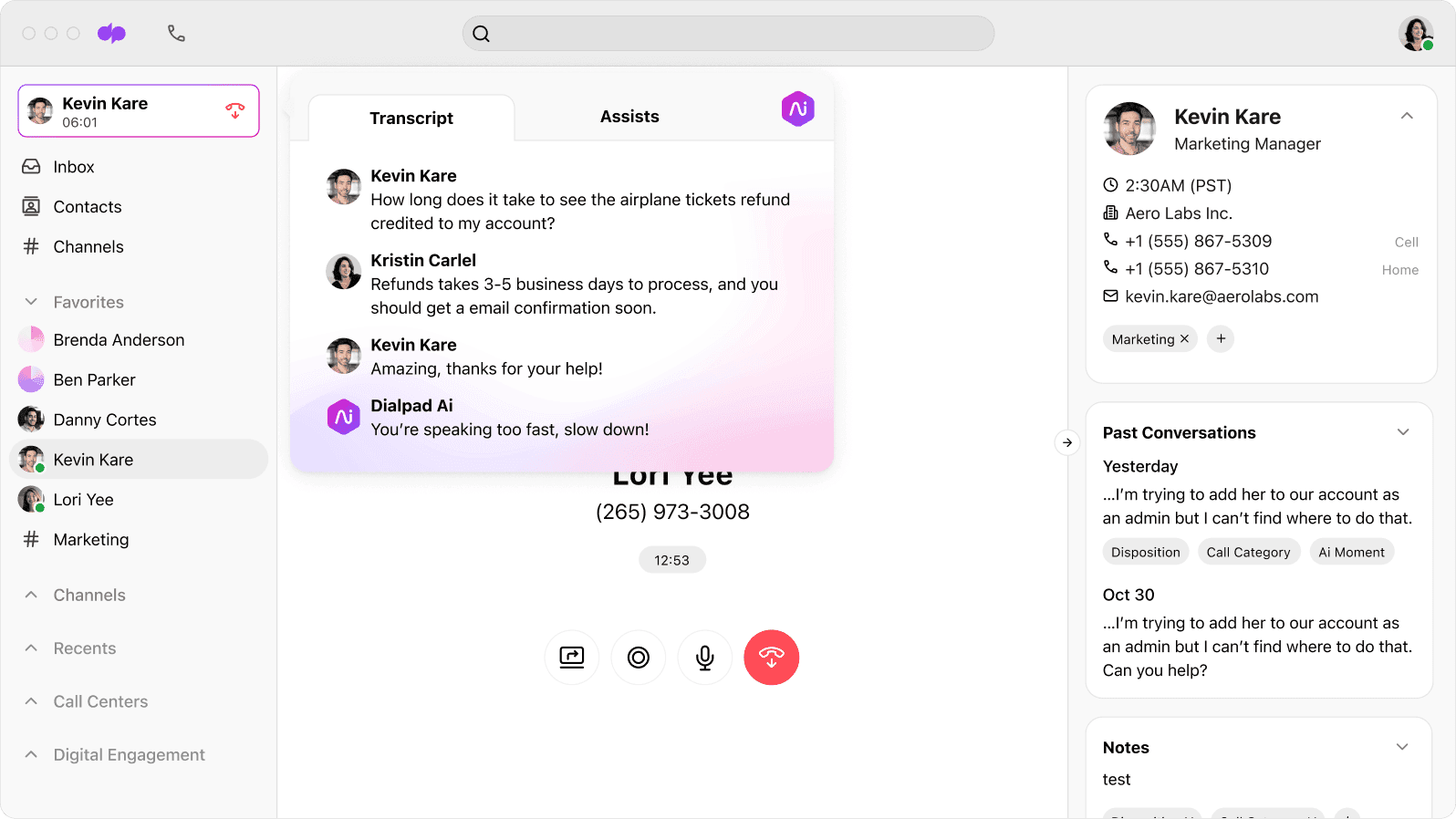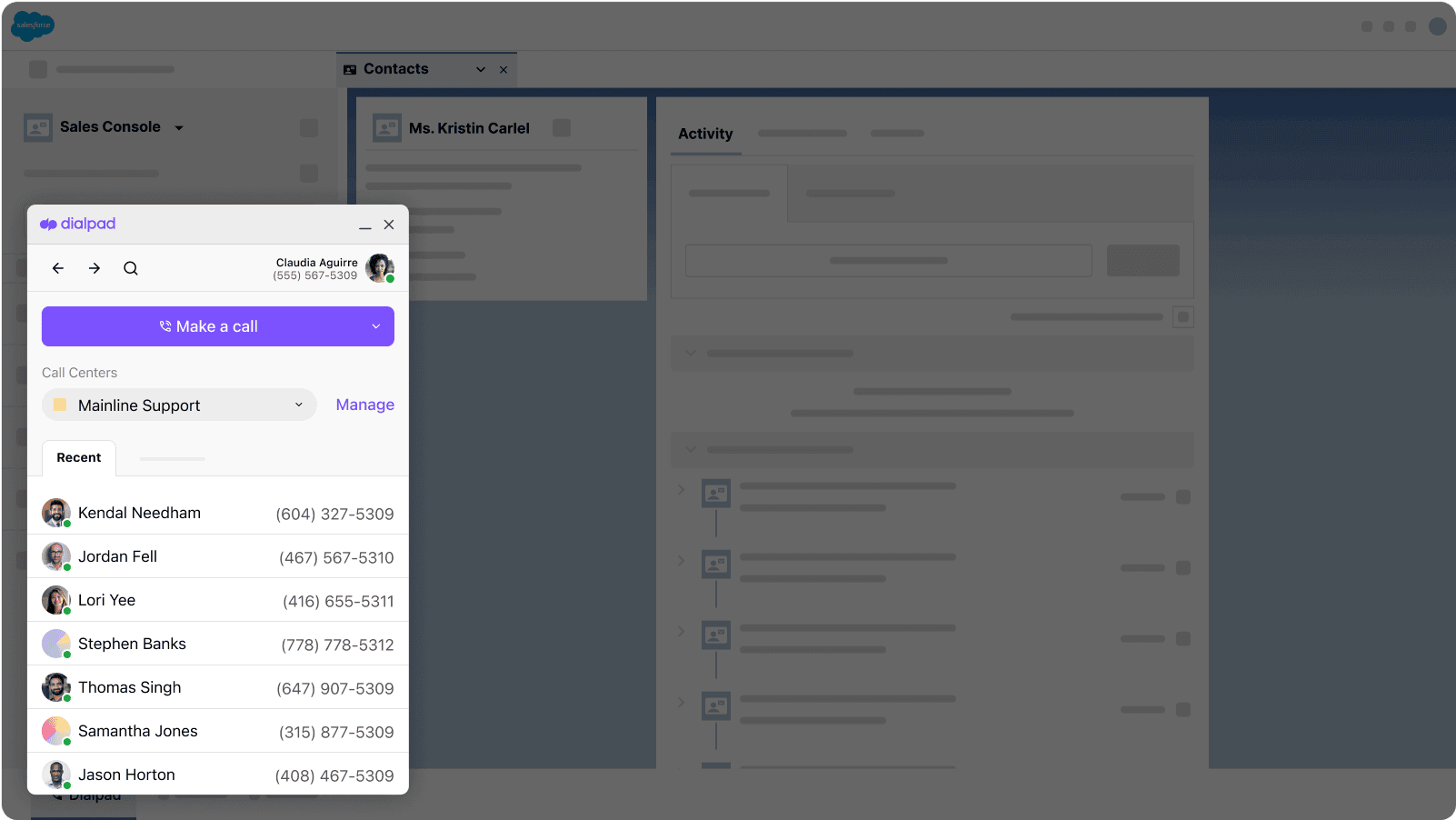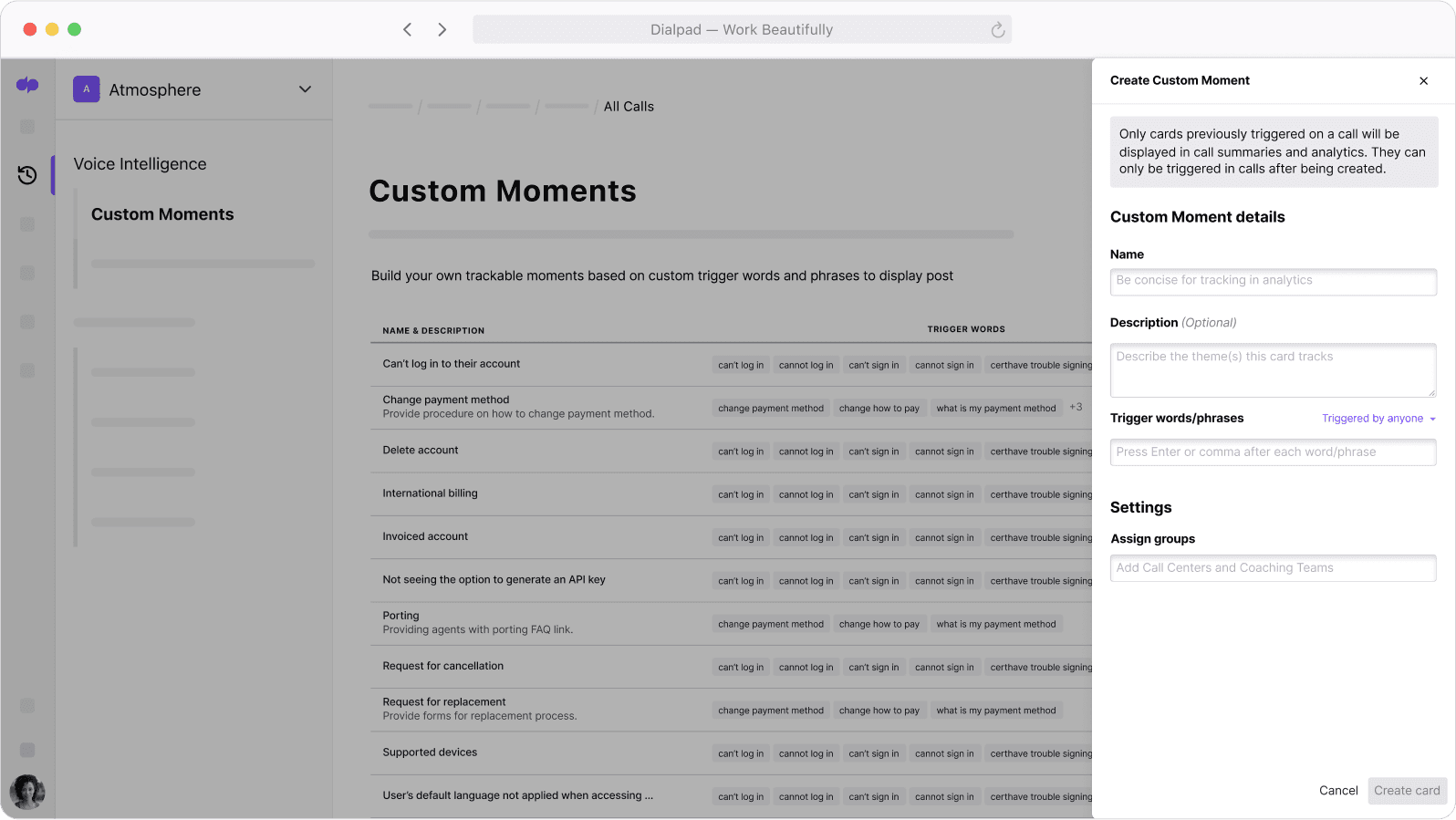Enterprise productivity, how to boost it + tools to help

Senior Content Marketing Manager

Tags
Share
Enterprise organizations aren’t like most businesses. Unlike your average business with a couple hundred employees, enterprises tend to have workforces of 5,000 or 10,000-plus employees (every company defines “enterprises” slightly differently, but businesses like Proctor and Gamble and Microsoft are without a doubt in the enterprise category).
Not only that, enterprises’ teams are also spread out around the world, with some employees working from offices while others work from home. With all of these variables and such huge teams, this makes business productivity a uniquely challenging problem.
So, how can these organizations maximize output while minimizing resources and staying competitive?
In this blog post, I’ll walk you through how we at Dialpad approach the concept of enterprise productivity, how our own enterprise customers overcome common productivity challenges, and some tips and tools to improve your own teams’ efficiency.
What is enterprise productivity?
Enterprise productivity refers to the capacity of a large organization (typically 10,000+ employees) to efficiently allocate and use its human, financial, and technological resources to achieve its goals and objectives.
It goes beyond simple metrics like revenue or gross profit—looking at this type of business productivity involves optimizing processes, right-sizing the tech stack, and ensuring that every facet of the business contributes to overall performance and success.
In other words, improving enterprise productivity involves a holistic approach that integrates people, processes, and technology.
Common productivity challenges enterprises face
Even though enterprise companies have huge budgets and resources at their disposal, many of them still encounter common challenges that hinder their efficiency—and problems don’t necessarily get easier to solve just because you’re a big company with a big budget. Some of the most prevalent issues include:
1. Lack of clear communication
In large enterprises, communication issues are exacerbated because teams are so much bigger and more scattered. Any common communication breakdowns that you’d find in a small company with 50 or 100 people get magnified when your Marketing team alone is, say, 200-people strong with teammates in the Americas, Europe, and Asia.
Misalignment of goals, unclear expectations, and working in silos are just a few of the communication challenges that are common for enterprises. Many of our own enterprise customers come to Dialpad with four or five different communications tools—that all do the same thing!—which not only is unnecessarily expensive, but also makes it difficult for their teammates to actually talk to each other (because some people are using Slack while others prefer to use a separate video conferencing app).
2. Rising customer expectations
Rising customer expectations pose an especially significant challenge for enterprises. As customers become accustomed to seamless, personalized experiences that are more typically offered by innovative startups and digital-native companies, larger enterprises might find it difficult to adapt swiftly and meet these expectations.
The sheer size and complexity of enterprises, combined with legacy systems, intricate processes, and bureaucratic structures, tend to hinder their ability to quickly pivot and implement the agile and customer-centric practices demanded by today’s consumers.
3. Measuring employee productivity
It can be particularly difficult to measure employee productivity in enterprises, mainly due to the sheer scale of these companies, their diverse operations, and inherently complex structures.
On top of that, traditional performance evaluation methods haven’t really evolved to capture the nuances of today’s remote and hybrid work environments. Many businesses measure employee productivity with time-tracking tools, but there’s quite a bit of debate over the effectiveness of this approach, and the work productivity definition is undergoing a long-overdue evolution.
4. Legacy systems and processes
On a related note, large enterprises almost always operate with legacy systems (think business phone systems, contact center software, and so on) and processes that are slow to evolve. This makes it hard to integrate new technologies and modernize their existing infrastructure, which becomes a time-consuming and resource-intensive challenge.
Similarly, decision-making in large enterprises can be slow and bureaucratic, thanks to complex hierarchies, multiple layers of approval, and the need for consensus—which can seriously impact overall productivity.
5. Coordinating global operations
Finally, because they have a massive global presence, enterprises struggle with coordinating operations across different time zones, cultural differences, and regulatory landscapes. There isn’t really a silver bullet that solves this, unfortunately, because this generally comes with the territory—but there are ways to mitigate these challenges with a good communications tech stack and well-documented processes (which we’ll get into below).
Tips for improving enterprise productivity
Now, let’s look at some practical tips to help your teams work more productively:
Assess and track where you currently stand
Before you can determine a strategy for how to improve team productivity, you need to know where you stand. So, step one is to simply measure productivity in the workplace. You don’t need to set any goals yet—just start by measuring.
If you don’t know how to measure productivity in the workplace, that’s okay. You can use whatever metrics best suit your team—for example, if you run a sales team, you could track the number of opportunities generated, the number of dials your SDRs made this month, and so on. The main thing is to have a starting point. From there, you can start coming up with ideas to improve on those numbers.
Make cross-team collaboration as seamless as possible
One of the biggest obstacles to communication and collaboration in an enterprise is the (usually) unwieldy tech stack. It’s common for enterprises to have a few business phone systems or VoIP calling apps, a few video conferencing tools, a few messaging apps… You get the idea.
Take Randstad, for example. They’re a huge enterprise—and the biggest recruiting firm in the world. “All our teams were using different legacy tools and desk phones to stay connected around the globe,” says Rinio Veeris, their IT Specialist.
It hindered employees’ productivity instead of helping, it was time-consuming for the IT team to manage so many redundant tools—and it definitely was not cost-effective. So, they consolidated all of those channels into a single enterprise communications solution that gave them voice calling, video meetings, SMS/MMS and instant messaging, and even an outbound + inbound contact center—all on an AI-powered platform:

“Now, we have a unified contact center platform for all our recruiters and consultants,” says Rinio. “Dialpad’s AI-powered features have helped us save 10% of time and speed up the candidate screening process.”
Establish clear performance metrics and goals
To hit your productivity goals, you have to first understand your current performance metrics. As opposed to time spent logged on (or in office), it’s generally best to set realistic and transparent expectations based on individual and team performance. In fact, recent research from the Journal of Management found that employee monitoring or surveillance could actually have the opposite effect that employers want—employees who are monitored are way more likely to take unapproved breaks and work slowly on purpose.
Consider employee experience and engagement
Let’s face it. The traditional 9-to-5 work model is on its way out. More and more employees are looking for flexible work arrangements, such as remote work or flexible hours, to accommodate diverse work styles and have more work-life balance.
Not everyone is at their most productive between the hours of 9am and 5pm. Some of us are night owls, while others are early birds. If we really wanted to improve enterprise productivity in the workplace (and home office), it’s probably wise to take these different working styles into account.
Improve onboarding and training
A good onboarding program is important in any scaling business, but it’s especially crucial for enterprises where new employees have a lot to catch up on it when it comes to established processes and tools.
Make sure to equip your workforce with the skills and knowledge they need to navigate these technologies and processes and ensure a smooth transition.
Use the right tools and technology
Speaking of equipping your employees, we can’t forget about software and apps. The Harvard Business Review estimates that “on average, the cost of a switch is little over two seconds and the average user in the dataset toggled between different apps and websites nearly 1,200 times each day.”
The more apps you use, the more of this “toggle tax” you end up paying in terms of time and energy. To consolidate your tech stack, though, you’ll need to collaborate closely with your enterprise IT team, as they’ll typically be the ones vetting requests for new tools and auditing the organization’s apps.
Types of tools to help boost enterprise productivity
So, which enterprise productivity tools are actually helpful? Based on our own experience as a distributed global business and conversations with our enterprise customers, we’ve identified a few distinct categories of software that teams should consider.
A holistic collaboration platform
Every enterprise needs to communicate. No matter what industry or department you’re in, or where in the world you are, you need some kind of communication and/or collaboration platform.
As I mentioned earlier, in many enterprises you’ll find multiple tools in the tech stack that all do very similar things. This is not ideal because not only are you paying more in SaaS subscription fees than you need to, it’s also more time-consuming for your IT team to manage and forces your team members to constantly toggle between different tools. The result: lower productivity.
For all of these reasons, it’s generally best to have a good unified solution. Instead of having one video conferencing app, another team messaging app, another enterprise phone system, and so on, why not just use one platform that lets you make phone calls, send instant messages, have video meetings, and even handle customer communications all in one place?
RE/MAX, for example, has over 100,000 real estate agents and countless brokerages around the world. Jamie Barcia, RE/MAX’s VP of IT, was in charge of leading this area of their enterprise digital transformation. “Our objective was to not only replace and modernize HQ’s telephony infrastructure, but also to integrate other systems into a single platform, creating a fully connected experience.”
Whether their agents needed to communicate with teammates or externally with clients, they could do it all in a single app.“ With everything aligned, employees can engage with their team and communicate both B2B and B2C, all within Dialpad,” says Jamie. “It’s a far more efficient solution, eliminating the frustration of having to consult an email directory over and over.”
This level of integration extended to the other tools RE/MAX’s team was using too. For example, their customer support team uses Salesforce—and if they were using another communications platform, their support agents would’ve likely had to toggle back and forth between Salesforce and whatever enterprise voice solution they were using.
But because they were using Dialpad, which has a sophisticated Salesforce integration, their agents could make all their calls and see those interactions right inside Salesforce:

“Our Support team wanted to be able to view their ‘omni-stats’—telephony, email, and chat—in one pane of glass under one location within Salesforce, without having to go to multiple applications to get that data,” says Jeanna Bash, RE/MAX’s Director of Enterprise Applications.
“Out of all the vendors we looked at, Dialpad had the strongest integration, allowing us to get that right out of the gate.”
A collaboration platform acts as a centralized hub for communication and project collaboration. Tools like Slack, Microsoft Teams, or Asana provide a space for real-time communication, file sharing, and collaborative document editing. These platforms break down silos, foster teamwork, and enhance overall collaboration within the organization.
Project management tools
A project management tool is helpful for teams like Product, Engineering, Marketing, and even Finance because it helps with planning, executing, and monitoring projects.
Tools like Asana, Trello, and Jira are commonly used to visualize tasks (via kanban board views), set priorities, and track progress. With features like calendar views and task boards, project management tools are especially useful for helping distributed teams stay organized and meet project deadlines.
AI tools
When it comes to increasing productivity, we have to include AI tools. Even though we’re still in the hype cycle stage of AI, there are already many different business areas where enterprises can start integrating AI tools.
For example, enterprise AI solutions like Dialpad Sell Center can help sales teams gather more conversational insights from the calls they’re having every day with prospects. Which competitors are coming up in discovery calls? What features or services do prospects seem most interested in?
Sales teams can set up any keyword triggers they want, and Dialpad Ai will flag every time these competitor names or keywords are spoken on a call:

In customer service, conversational AI chatbots and virtual assistants can provide immediate responses to a huge variety of questions, which shortens wait times and hold times for customers, and reduces the workload for support agents.
As an example, Dialpad’s Ai Live Coach does exactly this, leveraging natural language processing (NLP) to provide answers to support agents. Not only does this help agents find answers for customers more quickly, it also means that enterprise companies can get new agents up and running sooner, since they have an AI helper riding alongside them in customer conversations:

These are just a few of the many use cases for AI for customer-facing teams—learn more about AI in sales and AI in customer service!
Productivity tools
General productivity tools like Microsoft 365 and Google Workspace offer a suite of applications that cover documents, presentation decks, and spreadsheet creation, which are used by employees in almost every line of business.
Having access to the enterprise plans of these tools is pretty much table stakes today for employee productivity (and many of them are beginning to incorporate AI features too).
Workforce management solutions
Workforce management solutions help organizations with large contact center teams optimize their workforce processes including scheduling, attendance tracking, and performance management.
Platforms like Playvox come with features that integrate well with contact center solutions to handle agent scheduling, forecasting, and more:

Boost productivity across your enterprise
Integrating the right tools can be a transformative force for business productivity. Whether you’re navigating the complexities of your global operations, trying to get more insights out of the data you’re collecting, or leaning more into automation, there are many ways to improve enterprise productivity.
The key is to first determine which processes your team wants to streamline and understand what tools are already in your tech stack. Often, simply consolidating all the different apps your organization is already using can make a huge difference in productivity all on its own.
Is your enterprise looking to improve productivity?
Book a product tour of Dialpad and see how our AI-powered collaboration and customer intelligence platform can help improve your internal and customer-facing communications!
